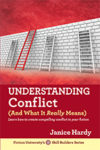By Janice Hardy, @Janice_Hardy
Ask any agent or editor to list the top three reasons manuscripts get rejected and you’ll find “not enough conflict” on that list. Conflict is at the core of every story, and without conflict, there is no story. It’s so vital, “conflict” and “story” are almost interchangeable when writers talk about it. It’s common to ask, “What’s your story about?” and have the author describe the conflict.
Which is part of the problem.
Since conflict covers such a wide range of storytelling, it isn’t always clear what people mean when they say “conflict.” Does it mean the plot of the story? The character arc? Does conflict mean the characters have to argue? Does it mean a physical battle? Does it mean soul-crushing angst or a mustached villain plotting against the hero at every turn?
No. Conflict fuels the plot and character arc, but they’re separate elements. You can have conflict without battles, without major angst, and without evil villains bent on world domination. Some of the best conflicts are those between characters who love each other deeply, but can’t agree on what to do about a problem.
I think the biggest reason writers struggle with conflict is that it’s not just one thing. Conflict is a one-two combo of a challenge faced and the struggle to overcome that challenge.
- The conflict of the plot (the physical challenges faced to resolve the problem)
- The conflict of the character (the mental challenges faced to resolve the problem)
These are the two sides of conflict and they appear in every story (and scene) in some fashion. Let’s look at each of them a little closer.
The Conflict of the Plot
A plot is external. It’s what the protagonist does to resolve the problem of the novel (the core conflict). The plot’s conflicts are also external, consisting of the individual challenges the protagonist faces on a scene-by-scene basis. Resolving these conflicts creates the plot and leads the protagonist from page one to the final page of the novel.
The conflict of the plot is what’s making it physically hard for the protagonist to do what she has to do.
For example:
- To sneak into the building, the protagonist must find a way to disable the security cameras and locks—the conflict (challenge) is the technology and security people preventing her from entering the building.
- To catch the love interest’s eye, the protagonist must attend a party she hasn’t been invited to—the conflict (challenge) is her attempt to get into that party when she’s being excluded.
Real conflict involves opposition to a goal and the challenges to overcome that opposition.
However, when people refer to the plot’s conflict in a scene, it’s often the goal they’re talking about—which is why writers can sometimes think their scene has conflict when it really doesn’t. They’re referring to what the protagonist has to do, not the challenge to achieve that goal. You might have a goal of emptying the dishwasher, but unless that task presents a challenge to complete it, it’s not a conflict.
For example:
- The protagonist must sneak into a building and steal the plans.
- The protagonist must ask her love interest out on a date.
These are all goals that could easily move a plot forward, but these “conflicts” are just tasks to be completed—there’s no challenge associated with achieving them. Without something in the way of completing these tasks, they’re nothing more than simple obstacles. The conflict (in the story sense of the word) is what’s preventing the protagonist from completing her goal. Otherwise, the protagonist can just waltz in and accomplish her task with little to no resistance. No resistance (no challenge) = no conflict.
The Conflict of the Character
A character conflict is internal. It’s the emotional struggle the protagonist faces to resolve her challenges. These conflicts make it harder for the protagonist to make decisions, because choosing what to do has emotional consequences, and often, the right choice is the one the protagonist doesn’t want to make.
The conflict of the character is what’s making it emotionally hard for the protagonist to do what she has to do.
For example:
- In order to steal the plans, the protagonist needs to use (and reveal) the thieving skills she’s been trying to keep secret from her new boyfriend. (She can’t get the plans and keep her secret, so she has to choose which is more important to her.)
- In order to get into the party, the protagonist must use the connections of the family who disowned her (She can’t meet her love interest without revealing the truth about her scandalous past, so she has to choose if love is worth the risk.)
The conflict of the character is the emotional struggle the protagonist faces while deciding what to do about the external problem. Risk the secret. Reveal the past. It makes the protagonist ask, “Is this goal worth the price I’ll have to pay to get it?” Sometimes the answer is yes, sometimes it’s no, and sometimes the protagonist tries her best to get the goal without paying the price, which rarely goes well for her.
However, when people refer to the character conflict in a scene, it’s often the character arc they’re actually talking about—which is why writers can feel all character conflict (internal conflict) needs to result in character growth, but it really doesn’t. You can have internal conflict without a character arc. The protagonist can struggle over the right choice without changing as a person.
For example:
- In order to steal the plans, the protagonist will have to struggle against exposing her criminal past. (Yet exposing that past does nothing to make her a better person or cause growth, it’s just a part of her the new boyfriend might not like, and he might break up with her over it.)
- In order to get into the party, the protagonist will have to struggle against relying on a family that disowned her. (Yet using the family does nothing to change the protagonist, and she’s not going to reconcile with them because of this.)
All the challenges offer internal struggles to resolve, but they’re not about changing the life of the protagonist in a fundamental way.
Conflict and the Character Arc
A character arc is how the character changes by undergoing the experiences of the novel. Since change comes from an internal struggle to make the right choice, the character arc uses the internal conflicts of the novel to cause that change. Often this change is positive and the character grows, but it can also be a negative change, turning a good or happy person into a bad or unhappy one. It could even be a change in perspective or belief, with a character ending the novel exactly where she started, just with a different worldview after her experiences.
The internal conflict shows the emotional struggle the character undergoes to change. The external challenges force the protagonist to face those internal struggles. What she decides to do affects who she is as a person and teaches her an important lesson—even if that lesson takes multiple attempts to sink in and effect change (which is part of the plot).
Angst over choosing the right course of action is not a character arc, though it does show internal conflict. Repeatedly making mistakes based on personal flaws or beliefs that keep you from being happy until you learn not to make those mistakes and change your ways is a character arc. And this takes both internal and external conflict to achieve.
For example:
- The protagonist who needs to abandon her criminal ways to be happy will face situations where she must choose to go the straight and narrow. Those choices will be hard, testing her resolve and giving her every opportunity to fail.
- The protagonist who needs to overcome her fear of rejection to find love will be put in situations where she can be rejected, so she can learn how to deal with them. Those situations will have consequences for failure, which will make it harder for her to overcome this problem.
The character arc uses the conflicts of the story to change the character.
In essence, conflict is all about making your characters struggle to solve problems. A lot. And you have multiple options for how to do that, so don’t feel there’s only one right way to create conflict in a novel.
What types of conflicts do you enjoy writing?
Looking for more tips on creating conflict? Check out my latest book Understanding Conflict (And What It Really Means), an in-depth guide to how to use conflict in your fiction.
 Janice Hardy is the award-winning author of the fantasy trilogy, The Healing Wars, and multiple books on writing, including Understanding Show, Don’t Tell (And Really Getting It), Planning Your Novel: Ideas and Structure and Revising Your Novel: First Draft to Finished Draft. She’s also the founder of the writing site, Fiction University. For more advice and helpful writing tips, visit her at www.fiction-university.com or @Janice_Hardy.
Janice Hardy is the award-winning author of the fantasy trilogy, The Healing Wars, and multiple books on writing, including Understanding Show, Don’t Tell (And Really Getting It), Planning Your Novel: Ideas and Structure and Revising Your Novel: First Draft to Finished Draft. She’s also the founder of the writing site, Fiction University. For more advice and helpful writing tips, visit her at www.fiction-university.com or @Janice_Hardy.
Website | Facebook | Twitter | Goodreads | Amazon | Barnes & Noble | iTunes | Indie Bound
Writer @Janice_Hardy Explains the 2 Sides of Conflict: Click To Tweet

Thanks so much for having me here today!
Thanks so much for being here, Janice, and with such a helpful post!
Conflict in its many forms is what carries a story along, and keeps interest. Thanks for exploring it in such depth.
Most welcome. I had a lot of fun digging into it.
Conflict is something I’m getting better at – and this post is so helpful. Thanks! :)
Glad to help!
Excellent post on conflict, Janice! Writing conflict that works (and understanding how to best use it) is one of my biggest challenges. This is extremely helpful. I’m off now to order the book!
Aw, thanks so much! I hope you enjoy it.
Great and informative post. If we look at the conflict in our lives, we see normal stuff (sometimes abnormal). People relate to characters who are faced with life choices where the character either makes the right decision or the wrong one.
Anyway, great stuff, Janice.
Thanks, Elizabeth, for featuring Janice.
Teresa
Thanks for coming by, Teresa!
I think it’s the personal, “Gee, what would I do?” type choices that really resonate, too. They’re so personal and relatable.
A very clear yet thorough analysis of conflict and character. Thank you for sharing this.